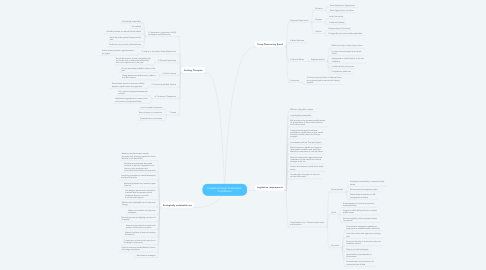
1. 'Keep Discovering Brand
1.1. Signature Experiences
1.1.1. Enhance
1.1.1.1. Visitor Experience Opportunity
1.1.1.2. Visitor Appreciation of Values
1.1.2. Engage
1.1.2.1. Local Community
1.1.2.2. Traditional Owners
1.1.3. Deliver
1.1.3.1. Best practice in Ecotourism
1.1.3.2. Ecologically and economically sustainable
1.2. Hidden Wonders
1.3. In Special Places
1.3.1. Experiences that
1.3.1.1. Reflect and rely on sites unique values
1.3.1.2. Conserve site ecological and cultural values
1.3.1.3. Appropriate in scale & nature to the site conditions
1.3.1.4. Contribute back to the park
1.3.1.5. Complement public use
1.4. Ecotourism
1.4.1. The Environmental values of National Parks are protected and preserved while being enjoyed
2. Guiding Principles
2.1. 1.Conservation, protection of QLD landscapes and biodiversity
2.1.1. Ecologically sustainable
2.1.2. Accredited
2.1.3. Should be reliant on natural/cultural values
2.1.4. Be all about the special features of the park
2.1.5. Preference to previously disturbed sites
2.2. 2. Unique or Innovative Visitor Experiences
2.2.1. Add to existing tourism opportunities in the region
2.3. 3. Diverse Experiences
2.3.1. Should be sensitive to and compatible with the current use or desired future settings and visitor experiences in the park
2.4. 4. Public Interest
2.4.1. Be not reasonably available outside of the park
2.4.2. Clearly determined as best use in relation to public interest
2.5. 5. Environmental Best Practice
2.5.1. Demonstrate sound commercial viability based on triple bottom line approach
2.6. 6. Consistant /Transparent
2.6.1. Fair, open and impartial assessment process
2.6.2. Assessment appropriate to nature, scale and location of proposed facility
2.7. 7. Lease
2.7.1. Level of capital investment
2.7.2. Rate of return on investment
2.7.3. Financial return to the state
3. Legislative requirements
3.1. Will be in the public interest
3.2. Is ecologically sustainable
3.3. Will provide to the greatest possible extent for preservation of site natural condition and cultural values
3.4. Is designed/managed to facilitate presentation, appreciation of site natural condition/cultural values (the Primary purpose)
3.5. Is consistent with the 'Primary Purpose'
3.6. Would require no significant change to lands natural condition and would not affect the conservation or cultural values
3.7. Would increase visitor appreciation and understand of the natural and cultural heritage of the site
3.8. Protect and conserve natural and cultural values
3.9. Provide place for people to visit and connect with nature
3.10. Triple Bottom Line - Environmental, social and economic
3.10.1. Environmental
3.10.1.1. Ecological sustainability on natural/cultural values
3.10.1.2. Environmental management plans
3.10.1.3. Partnerships/contribution to NP management activities
3.10.2. Social
3.10.2.1. Enhancements of community access to existing facilities
3.10.2.2. Degree in which facility will limit or restrict public access
3.10.2.3. General suitability of the propose location for purpose
3.10.3. Economic
3.10.3.1. Financial and managerial capability of proponent to establish/sustain the facility
3.10.3.2. Local job creation and support for existing jobs
3.10.3.3. Economic benefits to local community and traditional owners
3.10.3.4. Flow-on to local businesses
3.10.3.5. direct/indirect costs/benefits to Government
3.10.3.6. Financial return to government for commercial use of land
